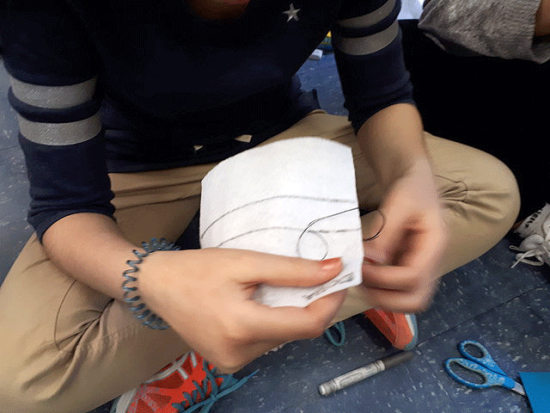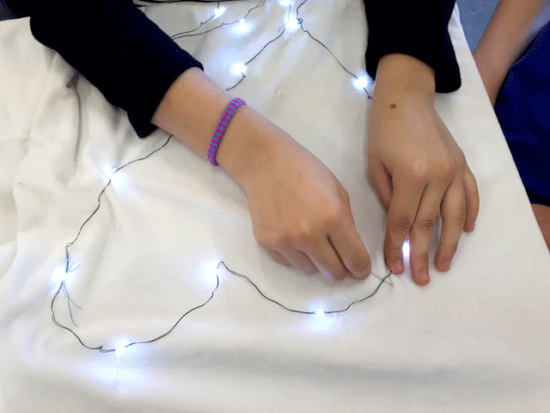Fashion Forward Learning
Arts Integration in the elementary classroom
As a Grade 6 generalist teacher I struggled this past year with teaching visual arts to my class of 28 students. This surprised me, as I had taught visual arts at a high school for the past 18 years. It was not due to a lack of ideas, knowledge of the arts, materials, or resources. It simply boiled down to the realities of teaching the curriculum of the core subjects along with preparing my students for mandatory provincial exams. There was no time to engage in meaningful and authentic art learning in the designated 50-minute weekly period. A month would pass and the students would still be working on a drawing. Their enthusiasm would dwindle and it showed in their projects. To counter this, I began to trim lessons: fewer discussions about works of art, less time to explore a new medium. I even reduced the size of paper that students worked on. Teaching art became a frustrating chore to maximize the minutes before the bell.
To solve this problem, I was advised to skim ideas off Pinterest and find a quick 50-minute project with step-by-step instructions. Chapman, Wright and Pascoe researched elementary teachers who routinely used Pinterest as a resource to build their lessons. They found that while Pinterest allowed teachers to easily access art-making ideas, the “activities on Pinterest provided things to do, but do not necessarily improve arts learning.”1 As I swiped over colourful images, it reminded me of what arts educator Arthur Efland l#_edn1abelled “the school art style.”2 Forty years ago, Efland proclaimed that a particular style of art was generated in elementary classrooms across North America. While art is habitually associated with self-expression, Efland observed that art making at the elementary level was tightly controlled and limited the child’s creative and expressive selves. Due to the children following the teacher’s step-by-step instructions, art projects contained a certain aesthetic that lacked imagination – thus the school art style. As I considered the step-by-step art lesson plans on Pinterest, I realized that my teaching was going in reverse. I abandoned Pinterest and instead reflected upon the ways the other subjects that I taught were interconnected with art.
What is Arts Integration?
Arts Integration may appear similar to cross-curricular learning, yet there are distinct differences. In cross-curricular learning, a teacher merges two subjects into a project with the goal of showcasing the content of both. Cross-curricular learning can bring about new knowledge for students concerning how the two subjects intersect. However, a significant critique of cross-curricular learning is that more often one subject becomes an add-on to the project.3 For example, educational researchers Clapp and Jimenez4 observed that in STEAM projects, the arts were mainly used to beautify projects. While there are intentions to utilize art as a creative force. the reality may be just a quick application of paint or glitter.
Arts Integration is “an approach to teaching in which students construct and demonstrate understanding through an art form.”5 Duma and Silverstein assert that Arts Integration is not just an activity. It engages students to think critically and imaginatively through the process of exploration and creation. The teacher’s role is to assist students in their creative explorations and allow for students to build their own knowledge. One central benefit of Arts Integration is that the learning is naturally diversified as students uncover their own approaches to completing a project. Furthermore, Smilan suggests that the goal of Arts Integration is to not simply design a project; it is to focus on the process and the act of inquiry.6 Experimenting, collaboration, creation, and reflection are a few of the principles of Arts Integration.7
Learning to let go
To embrace an Arts Integration approach, I had to address several obstacles. First, the timetable that divided up the subjects into neat 50-minute blocks would be abolished. I explained to my students that we would be “shutting down the classroom” to work on a project several times during the next three weeks. To my surprise, they cheered and were intrigued by this new approach to the daily schedule. Secondly, I had to expand upon what materials could be used in an art project. Having the pressure to display art projects on a bulletin board does not lend itself to unconventional materials. In addition, I wondered whether it was important that each student brought home a project. For some students, there is a sense of pride and a need to show family or friends. Other students are indifferent and the recycling bin becomes the drawing or painting’s final destination. Since I was leaning towards a group project, I would embrace photography to capture the process and provide the students with the photographs to show their families and friends. Finally, I had to redefine my role from a teacher who instructs to one who works alongside her students to support their learning.
Usually when designing a project, I consider projects that have worked in previous years. Instead, I invited my students to create a list of ideas. What struck me most was that the students wished to produce art that looked more “high school.” They were tired of cute art-making projects. Letting go of what elementary art should look like was the last step.
Recycling and sewing needles
Our Arts Integrated project centred on the students recycling an article of clothing and giving it a new function. For inspiration, we explored the work of Dutch fashion designer Iris van Herpen, who views fashion as “a dialogue between our insides and our outsides.” The 3D printed dresses of Danit Peleg provided insight into digital technologies. And the Sound Shirt, designed by fashion-tech company Cute Circuit, revealed how individuals can experience music through sensors placed within the clothing, allowing those who are deaf to “internalize(ing) something they cannot hear.”8 To ground the fashion project, three paths of exploration were selected: fashion for fun, fashion and technology, and fashion with a social message. The end goal was to present the finished clothing at a fashion show to be held in the classroom.
In Arts Integration, the process is as important as the product. Therefore, I used various types of formative evaluations throughout the exploration and experimentation phases: planning sheets, written reflections, and peer evaluations. For the summative evaluation, I created a rubric based upon the Quebec curricular competencies: to use information, to solve problems, to exercise critical judgment, and to use creativity. A few students declared that their own evaluation was based upon whether the item of clothing item fell apart during the fashion show.
While the goal was to encourage creative exploration and work alongside the students, I recognized that the students needed specific skills, particularly sewing skills. I devoted one afternoon to showing basic stitches, how to create a hem, and a few embroidery techniques (Fig. 1). Once the students had figured out how to thread a needle, several began embroidering their names into the bits of fabric. I was amazed that the following morning several students came to my desk to show off purses and cellphone cases that they had sewed that night.

For the next task, students worked in teams to select the type of clothing they wanted to alter. Before deconstructing the old clothing, students conducted research and created sketches. This process invited students to further develop their research skills, experiment with design elements, use mathematical concepts of scale and measurement, and develop their communication skills. During the fabrication, students quickly discovered that proper measurement was important before cutting a piece of fabric. In regards to Arts Integration, the students discussed and debated ideas, worked creatively, and reflected on artistic choices throughout the project. One team imagined creating a hoodie that would express the emotions of the wearer. To achieve this, they embedded different coloured lights into the fabric that the wearer could alter depending upon his/her feelings (Fig. 2). Another team experimented with methods to sew cut-up cans onto a jean skirt. Within each project, the students were solving artistic problems and applying knowledge and skills from other subjects, particularly math and language arts.

Fashion is our passion
To showcase this project, an afternoon fashion show was held in the classroom. Strings of lights formed a runway on the floor and House music played in the background. Each team wrote a text describing the inspiration behind their design. One student would read the text aloud while another student modelled the clothing. After rehearsing, the classroom was filled with excitement and nervous energy as students reworked their texts and other students practised walking with more swag. The students were more than pleased with their clothing projects. As for the teachers and parents who watched the final Fashion is Our Passion show – they were simply amazed.
Final thoughts
The obstacle of limited time to teach authentic and engaging art required me to re-evaluate what art making at the elementary level could be. Arts Integration provided a new approach to the art curriculum that enabled students to develop communication skills, draw upon mathematical knowledge, and address their needs for self-expression. Furthermore, this Arts Integration project revealed that art at the elementary level does not need to be a step-by-step instructional process. It can be a more truly creative undertaking that allows students to learn new skills, solve problems and express themselves through art.
Photos courtesy J. Etheridge
First published in Education Canada, August 2020
NOTES
1 S. Chapman, P. Wright, and R. Pascoe, “Criticality and Connoisseurship in Arts Education: Pedagogy, practice and ‘Pinterest©’, Education 3, no.13 (2018): 10.
2 A. Efland, “The School Art Style: A functional analysis,” Studies in Art Education 17, no. 2 (1976): 37-44.
3 H. H. Jacobs, “The Growing Need for Interdisciplinary Curriculum Content,” in (Heidi Hayes Jacobs, Ed.), Interdisciplinary Curriculum: Design and implementation, ed. Heidi Hayes Jacobs (ASCD Books, 1989), 1–11.
4 E. P. Clapp and R. L. Jimenez, “Implementing STEAM in Maker-Centered Learning,” Psychology of Aesthetics, Creativity, and the Arts 10, no. 4 (2016): 481.
5 A. L. Duma and L. B. Silverstein, “Arts Integration: A creative pathway for teaching,” Educational Leadership 76, no. 4 (2018): 57.
6 Smilan, C. (2016). Developing visual creative literacies through integrating art-based inquiry. The Clearing House: A Journal of Educational Strategies, Issues and Ideas, 89(4-5), 167-178.
7 L. B. Silverstein and S. Layne, Defining Arts Integration (The John F. Kennedy Center for the Performing Arts, 2010).
8 Billboard (2019). www.billboard.com/articles/news/7378153/sound-shirt-deaf-people-feel-music-cutecircuit-video
